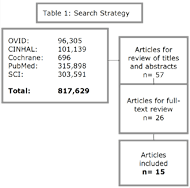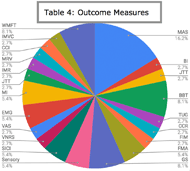Sarah Bulloch, OTS-21, Hongwu Wang, PhD.1, Cyndy Robinson, OTD1
Department of Rehabilitation Sciences1 College of Allied Health, University of Oklahoma Health Sciences Center
Background
Stroke is currently the leading cause of disability in the United States. After a stroke, 16% of individuals will live in a long-term care facility, 20% will require an assistive walking device, and 71% will be vocationally impaired. This happens because of the complexity of a stroke leading to complexity in the rehabilitation process. There is very little standardization of rehabilitation, and therefore clinicians and researchers are always working to better understand interventions that will best serve their patients and help them reach the greatest level of independence.
One intervention that has become increasingly studied in the last 10 years, is focal muscle vibration (FMV). The use of vibration as a therapeutic intervention dates back to the 1800s when vibration was used to relieve pain of patients with Parkinson’s. Since then, it has been used as an intervention for a variety of neurological diagnoses, but it’s mechanisms and protocol are not highly understood. Understanding the experimental protocols and establishing which outcome measures are commonly used in FMV studies in stroke rehabilitation may help improve consensus among researchers and clinicians.
Purpose
The purpose of this study is to examine the experimental protocols and identify the commonly used outcome measures in FMV based intervention studies after stroke.
methods

RESULTS
Overview
26 studies met all inclusion criteria, 11 were excluded. Of the 15 included, 3 studies looked at the effects of focal vibration on the lower extremity, and 12 looked at the effects of focal vibration on the upper extremity. Table 2 gives a brief overview of the search results (page 4).
Protocol
Protocol for application of focal vibration varied widely (see table 3). Frequency ranged from 60-300Hz. Amplitude was reported as “low amplitude” in 5 studies. 9 studies reported the amplitude numerically, with a range of .4mm-2mm. 1 study reported the amplitude as 10m, which cannot be converted for comparison. Duration of application varied from 5 minutes to 60 minutes.
| Study # | Freq. (hz) | Amp (mm) | Duration (minutes) | # of sessions |
|---|---|---|---|---|
| 1 | 60 | low* | 5 | 1 |
| 2 | 70 | low* | 30 | 1 |
| 3 | 100 | 0.2-0.5 | 10 | 9 |
| 4 | 100 | low* | 10 | 9 |
| 5 | 91 | 1.0 | 5 | 1 |
| 6 | 100 | 2.0 | 30 | 10 |
| 7 | 120 | 0.01 | 30 | 10 |
| 8 | 91 | 1.0 | 30 | 12 |
| 9 | 80 | low* | 60 | 40 |
| 10 | 100 | low* | 10 | 12 |
| 11 | 300 | 2.0 | 30 | 12 |
| 12 | 70 | 10m* | 30 | 6 |
| 13 | 120 | low* | 30 | 48 |
| 14 | 90 | .015 | 30 | 30 |
| 15 | 90 | 0.4 | 0.58 | nr |
| *= did not report amplitude in mm | ||||
Outcomes
For outcome measures, there were 21 different outcome measures used across the 15 studies. The most commonly used outcome measure is the Modified Ashworth Scale, which was used in 7 studies. Table 4 (at right) shows all outcome measures and how commonly they were used across studies.
CONCLUSION

KEY FOR CHARTS
BBT=box and block test; BW%= body weight shift percent; CCI=co-contraction index; EG= experimental group; EG1=experimental group 1; EG2=experimental group 2; EG3= experimental group 3; EMG= electromyography; FIM= Functional Independence Measure; FMA=Fugl-Meyer Assessment; FMA-UE=Fugl-Meyer Assessment Upper Extremity; FMV=focal muscle vibration; GS=grip strength; HGST=hand grip strength test; HMR=Hmax/Mmax ratio; JTT=Jebsen Taylor Hand function Test; MAS=Modified Ashworth Scale; MI=motricity index; MR=modulation ration; MVC=maximal voluntary isometric contraction; NR= not reported; RMP= progressive modular rebalancing; SICI= short-interval intracortical inhibition; SCI= Science Citation Index; TMS=transcranial magnetic stimulation; VAS= visual analog scale; VNRS=verbal number rating scale; WMFT=Wolf Motor Function Test
| Study | Participants (n) | Ages (years) | Onset (months) | Outcome Measures | Intervention Strategy |
|---|---|---|---|---|---|
| 1 | n=10 | 57±13 | 89±117 | BBTa | EG1: FMV EG2: TMS |
| 2 | n=10 | EG:45-63 | EG:>12 | FMAa, EMGa | EG: FMV |
| 3 | n=30 | EG:63.6±7.6 | EG:39.9±28.8 | MASa, WMFTa, SICIa, MIa | EG: FMV+PT CG: PT only |
| 4 | n=49 | EG:57.42±12.79 | EG:100.71±82.79 | WMFT, VAS, MAS | EG: FMV CG: placebo |
| 5 | n=36 | RG:27-83 | EG1: 2-35 EG2:2-73 EG3: 2-39 |
MASc | EG1: Rest EG2: Stretch EG3: FMV |
| 6 | n=30 | EG: 64.7±5.4 CG: 65.1±5.8 |
no reported | MASa, task, time,a, traject |
EG: FMV+PT CG: shamFMV+PT |
| 7 | n=22 | EG:60.3±15.3 CG:60.7±13.2 |
EG:15.5±14.9 CG:13.0±5.0 |
CCIa,b, MRa, MVCa |
EG: exercises+FMV CG: Exercise |
| 8 | n=10 | EG:62.0±9.0 CG:59±10.1 |
EG:11.0±4.3 CG: 9.2±1.9 |
BBTa,b, GS, Sensory |
EG: FMV only CG: PT only |
| 9 | n=20 | EG: 66±5 CG: 67±4 |
EG:5±2 CG:6±2 |
MASa, HMRa SICIa |
EG: Armeo-Power +FMV CG: Armeo-Power |
| 10 | n=nr | EG1: 31-69 EG2: 30-57 EG3: 2-7 |
EG1: 2-33 EG2: 2-4 EG3: 2-7 |
WMFTa,b MASa,b,c MIa,b, VASa,b |
EG1: FMV+RMP EG2: FMV+physiotherapy EG3: physiotherapy |
| 11 | n=32 | EG:62.59±15.50 CG:60.47±16.09 |
EGL 2-33 | HGSTa, MAS FIMa, VNRSa quickDASHa FMA-UEa, JTTa |
EG: FMV CG: sham FMV |
| 12 | n=10 | EG:62.6±8.6 | EG:21.6±18 | BBTa, GSa Sensory |
EG:FMV |
| 13 | n=44 | EG:60.3±15.3 CG:60.7±13.2 |
EG:15.5±14.9 CG:13.0±5.0 |
Toe-off(%)a Cadence Step Length Stride Lengtha Step Width Swing Velocity Gait Speeda |
EG: FMV+PT CG: PT only |
| 14 | n=32 | EG:53.31±8.37 CG:55.73±8.27 |
EG:56.94±25.73 CG:49.93±29.97 |
Postural sway Cadencea Gait Speeda P-step lengtha P single limb supporta |
EG: FMV + exercise CG: exercise |
| 15 | n=80 | EG: 54.7±10.6 CG:54.7±10.5 |
EG:2.0±1.3 CG: nr |
BW%a | EG: FMV (stroke) CG: FMV (healthy) |
| astatistically significant change first group listed bstatistically significant change in second group listed cstatistically significant change in third group listed |
|||||
REFERENCES
(15) Bonan, J. Butet, S. Jamal, K. Yelnik, A., Ponche, S. T., Leplaideur, S. (2017). Difference between individuals with left and right hemiparesis in the effect of gluteus medius vibration on body weight shifting. Neurophysiologie Clinique (47).
(9) Calabro, R. S., Naro, A. Russo, M., Milardi, D., Leo, A., Filoni, S., Trinchera, A., Bramanti, P. (2017). Is two better than one? Muscle vibration plus robotic rehabilitation to improve upper limb spasticity and function: a pilot randomized controlled trial. PLOS one (12)10.
(4) Caliandro, P., Celletti, C., Padua, L., Minciotti, H., Russo, G., Granata, G., Torre, G. L., Granieri, E., Camerota, F. (2012). Focal muscle vibration in the treatment of upper limb spasticity: a pilot randomized controlled trial in patients with chronic stroke. Archives of Physical Medicine and Rehabilitation (93).
(6) Casale, R., Damiani, C., Maestri, R., Fundaro, C., Chimento, P., Foti, C. (2014). Localized 100 hz vibration improves function and reduces upper limb spasticity: a double-blind controlled study. European Journal of Physical and Rehabilitation Medicine (50)5.
(10) Celletti, C., Sinibaldi, E., Perelli, F., Monari, G., Camerota, F. (2017). Focal muscle vibration and progressive modular rebalancing with neurokinetic facilitations in post-stroke recovery of the upper limb. La Clinica Therapeutica 168(1).
(8) Choi, W. H. (2017). Effects of repeated vibratory stimulation of wrist and elbow flexors on hand dexterity, strength, and sensory function in patients with chronic stroke: a pilot study. The Journal of Physical Therapy Science (29).
(11) Constantino, C., Galuppo, L., Romiti, D. (2016). Short-term effect of local muscle vibration treatment versus sham therapy on upper limb in chronic post-stroke patients: a randomized controlled trial. European Journal of Physical and Rehabilitation Medicine.
(2) Conrad, M. O., Scheidt, R. A., Schmit, B. D. (2011). Neurorehabilitation and Neural Repair 25 (1).
Gillen, G. (2016). Stroke rehabilitation: A function-based approach. St. Louis, MO: Elsevier.
(12) Jung, S. M., (2017). The effects of vibratory stimulation employed to forearm and arm flexor muscles on upper limb function in patients with chronic stroke. The Journal of Physical Therapy Science (29).
(14) Lee, S. W., Cho, K. H., Lee, W. H. (2013). Effects of a local vibration stimulus training programme on postural sway and gait in chronic stroke patients: a randomized controlled trial. Clinical Rehabilitation 27 (10).
(1) Liepert, J., Binder, C. (2010). Vibration-induced effects in stroke patients with spastic hemiparesis-a pilot study. Restorative Neurology and Neuroscience, 28.
(3) Marconi, B., Filippi, G. M., Koch, G., Giacobbe, V., Pecchioli, C., Versace, V., Camerota, F., Saraceni, V. M., Caltagirone, C. (2011). Long-term effects on cortical excitability and motor recovery induced by repeated muscle vibration in chronic stroke patients. Neurorehabilitation and Neural Repair (25)1.
(5) Noma, T., Matsumoto, S., Shimodozono, M., Etoh, S., Kawahira, K. (2012). Anti-spastic effects of the direct application of vibratory stimuli to the spastic muscles of hemiplegic limbs in post-stroke patients: a proof-of-principle study. Journal of Rehabilitation Medicine. (44).
(13) Paolini, M., Mangone, M., Scettri, P., Procaccianti, R., Cometa, A., Santilli, V. (2010). Segmental muscle vibration improves walking in chroni stroke patients with foot drop: a randomized controlled trial. Neurorehabilitation and Neural Repail 24(3).
(7)Paolini, M., Tavernese, E., Fini, M., Franceschini, V. S., Mangone, M. (2014). Segmental muscle vibration modifies muscle activation during reachin in chronic stroke: a pilot study.
Saggini, R., Bellomo, R. G., Cosenza, L. (2017). Vibration in neurorehabilitation: a narrative review. Medical Research Archives 5(11).